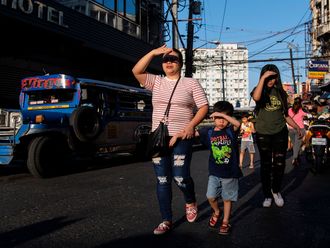Manila: Barely 24 hours after Rammasun struck Metro Manila on Wednesday, councillor Ricky Gino-Gino of Navotas City’s second district issued alerts over his Facebook page warning of the oncoming typhoon.
“To residents of San Roque village and all of Navotas: Typhoon Glenda (Ramasun) will hit Metro Manila. Its speed is 120 kilometres per hour. It has powerful winds. It will hit at 2am. Get flashlights and other items that you need,” Gino-Gino, 46, said in his post.
The message was short and easy for residents to understand.
A few minutes after the alert was issued, the warning went viral, giving villagers and city residents a heads up on what to expect.
Like clockwork, officials prepared evacuation centres and went on with their designated tasks.
By 8am on Thursday, the evacuation centre in the village of San Roque, had nearly 200 evacuees, including senior citizens, pregnant women, and children, among others.
Gino-Gino after the emergency said: “As of this time everyone in the village of San Roque are safe. There are no casualties. Thank you for the village officials in San Roque. Good job.”
Instead of awaiting instructions from the national government, the actions of local officials such as Gino-Gino have been replicated in local government units in thousands of villages and hundreds of towns across the country. Social media is changing the face of how grassroot leaders communicate with their constituents and the importance of these interactions are highlighted during times of oncoming disaster.
Navotas, a first class municipality, is located along the Manila Bay and is particularly susceptible to storm surges and tidal flooding that could inundate the coast at short notice. The fact that the city is located in a calamity-prone area has provided residents with enough experience and the proper mind set to live under constant threat of disaster.
As the threat from Rammasun ebbed, reports said at least 20 died and many were injured from the calamity in various parts of the country.
Ramassun affected nearly half a million people from four regions including the National Capital Region (Metro Manila), Central Luzon, Southern Luzon and Bicol.
Rammasun battered the country eight months after Haiyan, one of the most powerful cyclones to hit the planet in recent years, slammed the Eastern and Western Visayas. More than 6,300 people died from the disaster, with the highest number of casualties from Tacloban City.
The experience from typhoon Haiyan prompted the international community to issue last June the Tacloban Declaration.
The Tacloban Declaration emphasised the national government’s role in managing disasters and the local organ’s initiative as front liners.
The declaration made the clarification amid wrangling from government officials and international humanitarian groups over who has the say on humanitarian activities and managing disaster clean-up efforts.
At the same time the document also recognises “the importance of international cooperation, particularly in mega disasters, in support of the efforts of Affected States.”
“Affected States have the primary responsibility in facilitating financial, material and technical support from the international community,” it said









